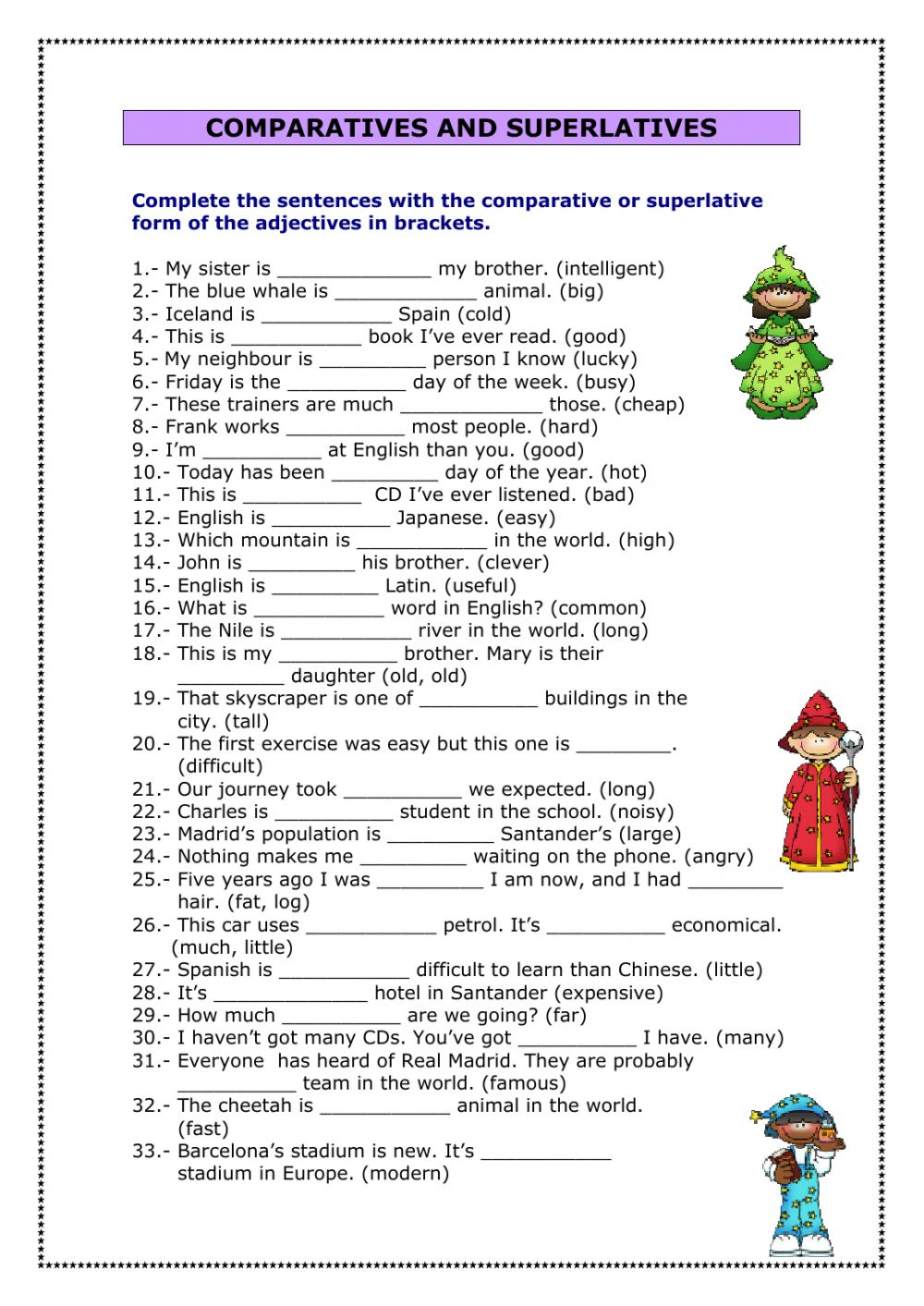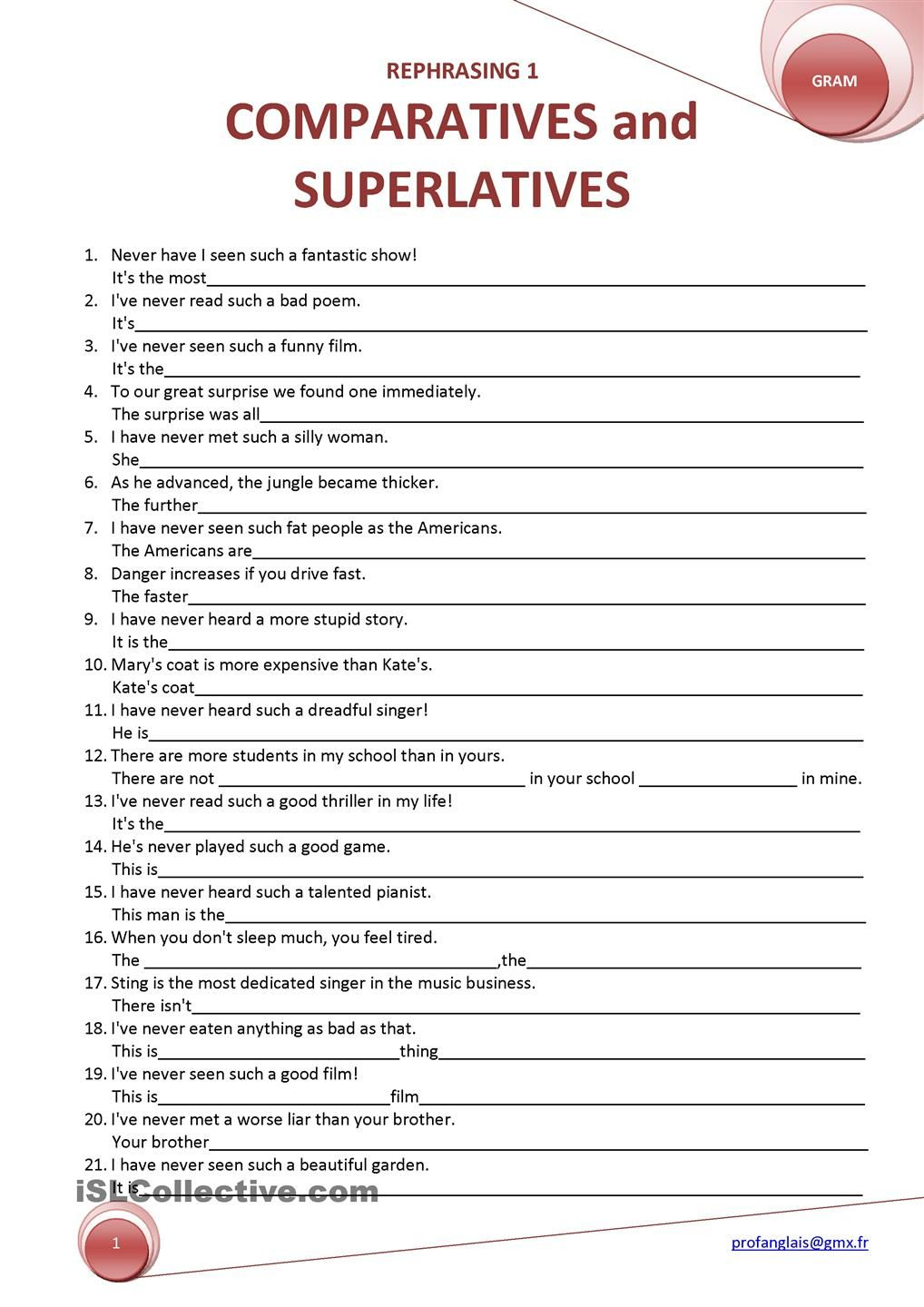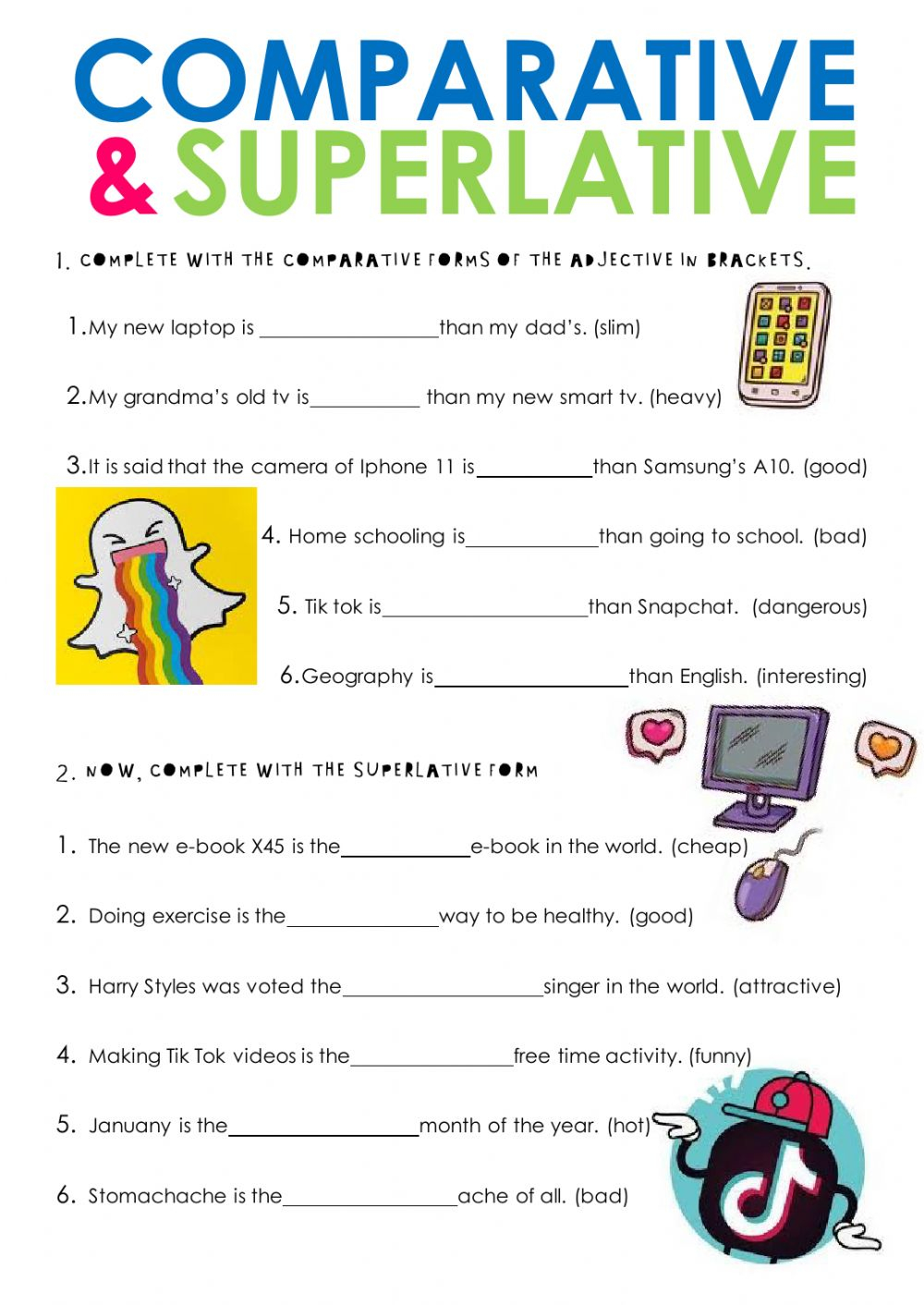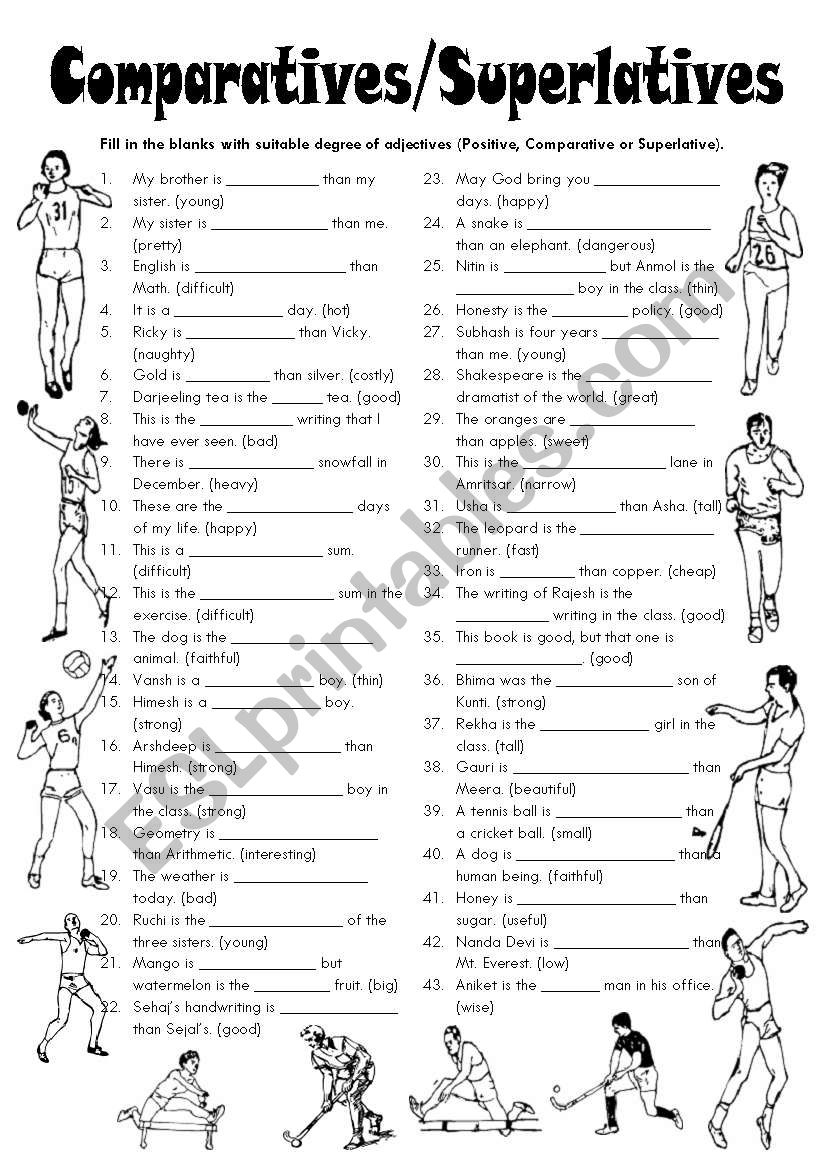
Mastering Adjectives: The Indispensable Role of Comparative and Superlative B1 Worksheets
English language proficiency is a journey, and at each stage, specific grammatical structures become crucial for effective communication. For learners at the B1 level of the Common European Framework of Reference (CEFR), the nuanced world of comparative and superlative adjectives represents a significant leap. This stage demands not just recognition but confident and accurate application. While classroom instruction, interactive activities, and real-world exposure are vital, the structured reinforcement offered by well-designed comparative and superlative B1 worksheets is truly indispensable. These worksheets provide the targeted practice necessary to solidify understanding, correct common errors, and build the fluency required for genuine B1 communication.
Understanding the B1 Learner and Their Needs
Before delving into the specifics of the worksheets, it’s essential to understand the B1 learner. At this intermediate stage, students can understand the main points of clear standard input on familiar matters regularly encountered in work, school, leisure, etc. They can deal with most situations likely to arise whilst travelling in an area where the language is spoken. They can produce simple connected text on topics that are familiar or of personal interest, and they can describe experiences and events, dreams, hopes, and ambitions and briefly give reasons and explanations for opinions and plans.

However, B1 learners often grapple with precision and nuance. While they might grasp the basic concept of "bigger" or "the biggest," they may struggle with irregular forms, applying the correct structure in complex sentences, or differentiating between similar concepts (e.g., "as…as" vs. "than"). They need opportunities to move beyond passive recognition to active production, making comparative and superlative B1 worksheets a cornerstone of their learning.

The Core Concepts: Comparatives and Superlatives

Comparative adjectives are used to compare two nouns, indicating which one has more or less of a particular quality. The general rules involve adding "-er" to short adjectives (e.g., tall -> taller) or using "more" before longer adjectives (e.g., beautiful -> more beautiful). Superlative adjectives, on the other hand, compare three or more nouns, identifying the one that possesses the highest or lowest degree of a quality. This usually involves adding "-est" to short adjectives (e.g., tall -> tallest) or using "most" before longer adjectives (e.g., beautiful -> most beautiful). Both forms require the use of "than" after comparatives and "the" before superlatives.

Crucially, both categories feature irregular forms (e.g., good -> better -> best; bad -> worse -> worst; far -> farther/further -> farthest/furthest), which pose a common challenge for learners. Additionally, the structure "as…as" for showing equality or similarity, and its negative form "not as…as" for showing inequality, are vital for a comprehensive understanding of comparison at the B1 level. Effective comparative and superlative B1 worksheets must systematically address all these facets.

Why Worksheets Are Essential for B1 Learners
In an era of digital learning, the humble worksheet might seem old-fashioned, but its pedagogical value remains immense, especially for grammar acquisition:
- Structured Practice: Worksheets provide a controlled environment for learners to apply grammar rules without the pressure of spontaneous conversation. This allows them to focus solely on the linguistic structure.
- Reinforcement: Repetition is key to mastering grammar. Worksheets offer numerous opportunities to practice the same concept in varied contexts, solidifying the rules in the learner’s mind.
- Self-Paced Learning: Students can work through exercises at their own speed, reviewing rules or consulting resources as needed. This fosters autonomy and caters to different learning styles.
- Identification of Gaps: Errors made on worksheets highlight specific areas where a learner needs more support. This allows teachers to provide targeted intervention and students to focus their revision.
- Tangible Progress: Completing a worksheet and getting answers correct provides a sense of accomplishment, boosting confidence and motivation.
- Variety of Exercise Types: Good worksheets move beyond simple gap-fills, incorporating diverse tasks that engage different cognitive skills and make the learning process more dynamic.



Designing Effective Comparative and Superlative B1 Worksheets

Creating high-quality comparative and superlative B1 worksheets requires careful consideration of the B1 learner’s cognitive abilities and common error patterns. Here are key elements to incorporate:
- Clear Instructions: Instructions must be concise and unambiguous, perhaps even with an example provided. B1 learners can follow complex instructions, but clarity reduces frustration.
- Gradual Difficulty: Start with simpler tasks (e.g., forming comparatives/superlatives from a list of adjectives) and progressively introduce more complex ones (e.g., sentence transformation, error correction, contextualized gap-fills).
- Contextualization: Grammar should not be taught in isolation. Worksheets should embed comparative and superlative structures within meaningful contexts – describing people, places, objects, or making personal choices. This makes the grammar more relevant and memorable. For instance, comparing two cities for a travel itinerary, or describing family members.
- Inclusion of Irregular Forms: Dedicate specific sections or integrate irregular adjectives frequently throughout the worksheets. Repetition is crucial for memorizing these exceptions.
- Focus on "Than" and "The": B1 learners often forget these crucial articles and conjunctions. Exercises should explicitly prompt their use.
- "As…as" Structures: Include exercises that differentiate between comparative forms and "as…as" structures, as these can be confusing. For example, "Sarah is as tall as Tom" vs. "Sarah is taller than Ben."
- Error Correction Tasks: Present sentences with common comparative/superlative errors and ask students to identify and correct them. This develops critical thinking and reinforces correct usage.
- Sentence Transformation: Tasks where students rewrite sentences using a different comparative/superlative structure (e.g., "The blue car is faster than the red car" to "The red car is not as fast as the blue car") are excellent for demonstrating flexibility and understanding.
- Productive Tasks: Beyond simple fill-in-the-blanks, include tasks that require students to generate their own sentences or short paragraphs using the target grammar. This bridges the gap between controlled practice and free production.
- Answer Keys: Essential for self-correction and independent learning, allowing students to check their work and understand where they went wrong.
Types of Exercises to Include in Comparative and Superlative B1 Worksheets
A varied approach keeps learners engaged and addresses different learning styles. Here are some effective exercise types for comparative and superlative B1 worksheets:
- Gap-Fill Exercises:
- Simple: "Mount Everest is the (high) mountain in the world."
- Contextualized: "Living in the city is (expensive) _____ living in the countryside."
- Sentence Completion/Expansion:
- "My old phone was slow, but my new one is __."
- "London is a big city, but Tokyo is ___."
- Sentence Transformation/Rewriting:
- "The train is faster than the bus. (Use ‘not as…as’)" -> "The bus is not as fast as the train."
- "This is the most interesting book I’ve ever read. (Use ‘more interesting’)" -> "I’ve never read a more interesting book."
- Picture Description/Comparison:
- Show two or three images (e.g., different houses, cars, people) and ask students to write sentences comparing them using various adjectives.
- "Look at these two houses. Describe which one is bigger, older, more modern, etc."
- True/False Statements with Justification:
- Provide statements using comparatives/superlatives (e.g., "The Pacific Ocean is the biggest ocean in the world. True/False? Why?"). This encourages research and critical thinking.
- Information Gap Activities:
- Students work in pairs. Each has a partial set of information (e.g., details about two different restaurants). They ask each other questions to complete their information and then compare the restaurants.
- Opinion-Based Questions/Discussion Prompts:
- "Which is more interesting, history or science fiction?"
- "What’s the best way to relax after a long day?"
- "Who is the most famous person from your country?" (Can be written answers or speaking prompts).
- Survey/Interview Tasks:
- Students survey classmates using comparative/superlative questions (e.g., "Who in our class is the funniest?"). They then report their findings.
- Paragraph Writing Prompts:
- "Compare two cities you know well."
- "Describe the best holiday you’ve ever had."
- "Write about three different jobs, comparing their benefits and drawbacks."
- Role-Playing Scenarios:
- Students act out situations requiring comparisons, such as shopping for an item, choosing a holiday destination, or debating the merits of two ideas.
Integrating Worksheets into a Broader Curriculum
While invaluable, comparative and superlative B1 worksheets should not be used in isolation. They are most effective when integrated into a comprehensive lesson plan:
- Pre-Worksheet Activities: Begin with a clear explanation of the grammar rules, using visual aids, examples, and eliciting existing knowledge from students. Engage in controlled oral practice before handing out the worksheets.
- During Worksheet Completion: Monitor students as they work, offering assistance and clarification. Encourage peer-checking and discussion.
- Post-Worksheet Activities: Review answers collectively, addressing common errors and reinforcing correct forms. Follow up with freer, communicative activities where students can use the grammar in speaking or writing tasks. This could involve debates, presentations, or creative writing pieces that naturally require comparative and superlative structures.
- Recycling and Review: Regularly revisit these structures in subsequent lessons through quick warm-up activities, short quizzes, or integration into new topics.
Common Pitfalls and How Worksheets Can Help
B1 learners often make predictable errors with comparatives and superlatives. Well-designed worksheets can directly target these:
- Double Comparatives/Superlatives: Using "more taller" or "most biggest." Worksheets with error correction exercises are excellent for addressing this.
- Forgetting "The" with Superlatives: "He is best student." Worksheets can have dedicated sections where students fill in missing articles.
- Misuse of "Than": Omitting "than" or using "then." Fill-in-the-blank exercises with options can guide students.
- Incorrect Irregular Forms: "Gooder" instead of "better." Repetitive practice with irregulars in various contexts on worksheets is crucial.
- Confusion with "As…as": Not differentiating between "taller than" and "as tall as." Targeted transformation exercises help clarify this.
By strategically designing exercises that anticipate and address these common errors, comparative and superlative B1 worksheets become powerful diagnostic and corrective tools, guiding learners towards greater accuracy and fluency.
Conclusion
The journey to B1 English proficiency is marked by the acquisition of increasingly sophisticated grammatical structures, and comparative and superlative adjectives are a prime example. For intermediate learners, mastering these forms moves them beyond basic communication to more nuanced and expressive language use. In this critical phase, comparative and superlative B1 worksheets emerge as an indispensable resource. They offer the structured, repetitive, and varied practice necessary to transform abstract rules into automatic usage.
From simple gap-fills to complex sentence transformations and creative writing prompts, well-crafted worksheets provide a scaffold for learning, allowing students to build confidence and accuracy at their own pace. When integrated thoughtfully into a broader communicative curriculum, these worksheets empower B1 learners to confidently describe, compare, and express opinions, ultimately paving the way for higher levels of English proficiency. They are not merely busywork but a vital component in the pedagogical toolkit for any teacher aiming to solidify their students’ grasp of comparative and superlative forms.
